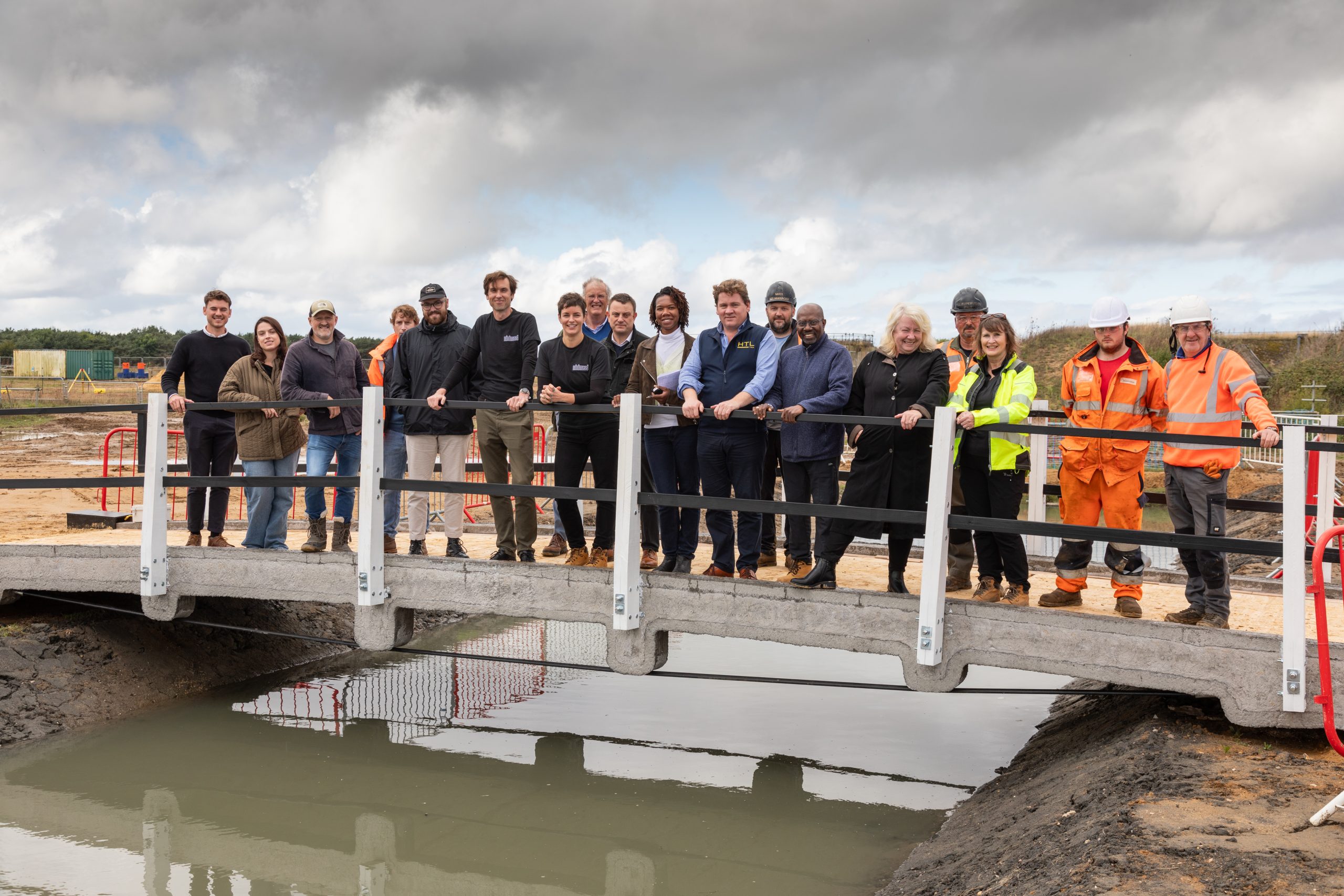A demonstrator footbridge has been successfully built using 3D-printed concrete beams, and could the start of a new era of structure building according to startup minimass.
The first-of-a-kind pilot project saw the fully instrumented demonstrator footbridge constructed at the Constructionarium site in Norfolk, with two 10.8m long minimass beams, Scottish glulam timber decking and timber parapets.
minimass believes this milestone will pave the way for low-carbon, low-cost footbridges to be constructed using 3D-printed concrete beams.
“The next step for us is to shout about this a lot,” said minimass founder and chief executive Andy Coward.
“We want to make sure that every single person in the construction industry in the UK and beyond has heard of minimass and can understand that this is possible.”
The challenge with creating the footbridge came in making the concrete beams reinforced and compliant to Eurocode 2.

“The big challenge with 3D printing is whether or not you can reinforce,” Coward said.
“What we’ve done at minimass is find a way to reinforce 3D- printed concrete. That’s our key structural differentiator compared to any other bridge or 3D-printed structure that you’ve ever seen or that anyone's ever seen.”
As well as creating reinforced 3D-printed concrete, minimass wanted to relook at how concrete is traditionally formatted and created.
“It’s this question of reinforcement,” Coward said. “We thought ‘Let’s use concrete in places where we have compression and let’s use steel in places where we have tension. Then let’s get rid of all the rest of the material’.
“Rectangular concrete beams are only rectangular because the easiest box to make to pour your concrete into is a rectangular box.
“If you remove your construction constraints, cost of labour and formwork, then the best way to span from A to B is to make a truss, which is why steel structures are trusses in a lot of cases.
“What we ended up doing was really finding a way to cost effectively make concrete trusses.”
Compared to typical steel or concrete footbridge designs, excluding foundations and prelims, minimass said this bridge provides a supply cost saving of 40% and an embodied carbon reduction of 30%.
Even with the benefits, minimass has struggled to get its product to market.
minimass commercial director and co-founder Sarah Blake said: “The challenge that we generally have found over the last year of getting this market were that people get it, they understand it, they believe that it can work – but no one wants to be the first.”
The project was predominantly funded by an Innovate UK Net Zero pre-commercialisation grant which helped get the project off the ground in a particularly ruthless industry.

“There wasn’t a great deal of trial and error involved in the concept, in the sense that understanding where forces go but being a startup in the construction industry is immediately a challenge,” Coward said.
“It’s an industry which is well-established and highly fragmented, but with necessarily strict controls on things like designs and new ideas.
“The questions of risk, in particular, for new ideas make starting out very, very difficult.”
Data on strain and temperature in the beams will be gathered over the coming six months to map the performance of the bridge and demonstrate the evolution of the concrete strength and creep over time.
While people were receptive to the idea initially, Coward states that it was only half the battle in getting the product to where it is now.
“People are receptive to the ideas and certainly, when you talk to the engineering teams at whatever contractors or design firms you're talking to, they get it, but you need more than that,” he said.
“It’s a question of risk for them too and risk for a contractor can come in all sorts of different ways.
“Design risk is only one type of risk, but let’s say we’ve squared off design risk - then you have the question of procurement risk, warranties and insurance cost.
“Is it really going to cost what we say it's going to cost? Can we point to decades of data on constructed buildings?
“We can’t, so the questions of procurement and insurance were so significant that they formed a big part of the justification for doing our grant funded project at Constructionarium.”
Having been designed to be easily disassembled, once testing is complete, the bridge will be gifted to Constructionarium, joining the centre’s project roster.
Like what you've read? To receive New Civil Engineer's daily and weekly newsletters click here.
 New Civil Engineer Civil engineering and construction news and jobs from New Civil Engineer
New Civil Engineer Civil engineering and construction news and jobs from New Civil Engineer




Have your say
or a new account to join the discussion.